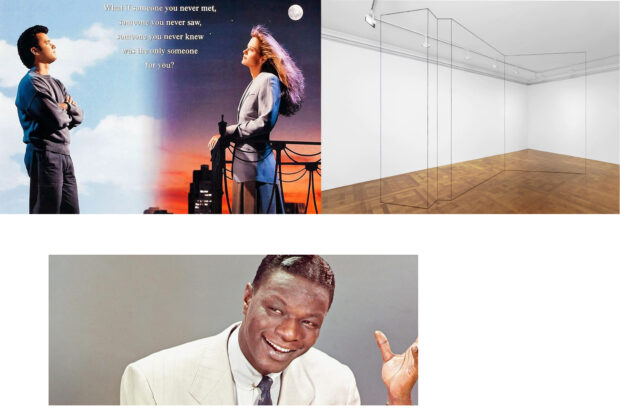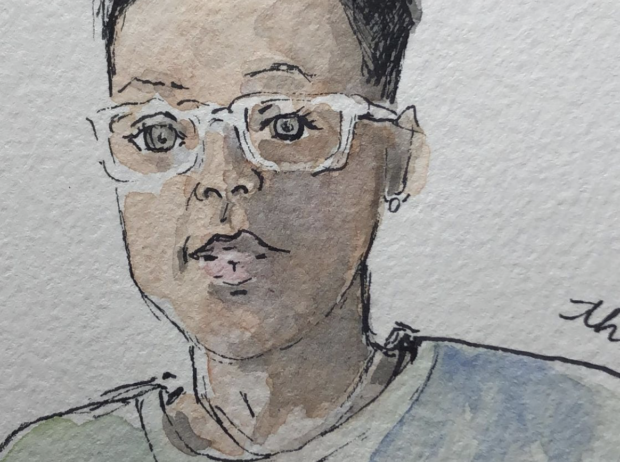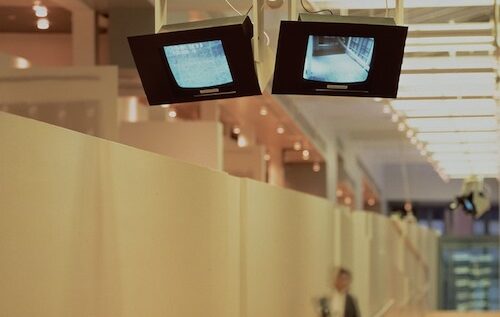Editor’s Note: This review was written directly following Marina Abramović’s lecture at the Institute of Fine Arts on March 1, 2011. It has been reprinted here in its original form.

Courtesy the Institute of Fine Arts at NYU.
A long duration is sublime. — Immanuel Kant
Although it is safe to assume that almost everyone who attended Marina Abramović’s recent lecture at the IFA, had seen her in person fairly recently, few, if any, had ever seen her speak: like all of her best-known performances, The Artist is Present (2010) at MoMA was completely wordless. In the very least, Abramović’s IFA lecture proved that the absence of speech in her performances is not due to any lack of ability on the part of the performer. She was lucid, frank, and insightful, managing not only to set her work into intelligent dialogue with a wide range of her contemporaries (Chris Burden, Gilbert and George, etc.), but also to be quite funny and entertaining along the way. By the end of the talk, one really felt to have gotten a good sense of Abramović’s personality. This of course shed a good deal of light on her work, though perhaps not in the direct sort of way that one would expect. Rather, the ease by which her personality came through in speech only threw into relief how little of that personality comes across in her performances. The type of encounter that occurs in the latter is entirely different in nature.
Abramovic’s lecture touched on many issues: the importance of long temporal durations in her work, a conception of the parts of the body as instruments of performance, her own path to becoming a performance artist, and many others. She began by reading a manifesto and went on to show a series of video excerpts of performances, choosing each from a DVD menu screen and discussing them freely, without a transcript or predetermined order. The present essay will not even attempt to map out the territory that she covered; for this, one would be better off simply watching the video recording of the lecture that is available on the IFA’s website. Instead, I would like to reflect on just a few aspects of the lecture that I found particularly helpful in interpreting her work.
The manifesto was divided into short, individually titled sections. Each section opened with a series of terse statements in the form “an artist should…” and closed repeating one of them three times. Some of the statements were familiar ethical precepts: an artist should not lie, steal, or kill. Others stipulated a certain kind of experience conducive to art making: an artist should be well acquainted with nature, solitude, suffering, and silence. On the whole, the manifesto prescribed a life roughly akin to that of a monk (at one point direct reference was made to Buddhist monasticism), although certainly not a wholly orthodox one, for “an artist should be erotic” as well.
Before she began reading the text Abramović mentioned how “old-fashioned” it is to write a manifesto, and that she could not help doing so without a certain sense of humor. In contrast to the genre’s traditional predisposition toward iron laws of historical and philosophical necessity, Abramović’s text was playfully interspersed with statements that read like rules of thumb born out of practical experience. The most conspicuous example of this was the thrice-repeated statement, “an artist should avoid falling in love with another artist,” which clearly refers to her relationship with former partner and artistic collaborator Frank Uwe Laysiepe (known as Ulay). If the use of the words “should avoid” here, rather than the more definitive “should not” used throughout the rest of the text, suggests a lingering degree of ambivalence, repetition lent them a disarming, almost therapeutic quality.
Other parts of the manifesto seemed to confront difficult periods of Abramović’s career with a similar sense of levity. One of these came up explicitly after the lecture during the question and answer session, when she was asked to address criticisms of her performance reenactments. Though prominent at least since her show at the Guggenheim in 2005, the debates surrounding these reenactments still feel fairly current. Some weeks ago, for example, I saw a lecture by Martha Rosler in which she criticized the whole phenomenon of re-performance in recent years as a capitulation to the prerogatives of the market and the institution (though she did not mention Abramović by name). Abramović’s response to the question was familiar and seemed fairly well rehearsed. The more provocative engagement came implicitly through a number of statements in the manifesto, such as the following: “an artist should avoid his own art pollution” (repeated three times), “an artist should not repeat himself,” “an artist should not compromise…in regards to the market,” “an artist should not make themselves into an idol.” Wittingly or not, such passages read as restatements of her critics’ core premises, concentrated, however, into such a dense, aphoristic form that it becomes difficult to follow them through to their usual conclusions.
In this way the manifesto opens up a space of productive ambiguity that could help hold off that stale, polemical state in which such debates often come to rest. After all, what exactly does it mean for Abramović to state that, “an artist should not repeat himself”? Taken at face value this would seem to bar not only her reenactments, but also the incessantly repetitive nature of the original performances, as well as the repeated phrases that close each section of the manifesto. It seems unlikely that such conceptual dissonance could be sorted out without unraveling the concept of repetition itself, whether by expanding it into a pervasive, inviolable fact of life (heartbeats, for example) or jettisoning it altogether as utter fiction (we never step in the same river twice). A similar dilemma arises out of the statement “an artist should not make themselves into an idol.” An artist who sets out to foreclose the possibility of becoming an object of false worship will produce work that tends toward one of two poles: on the one hand, total divestment of all reference to the sacred in order to avert any possibility of profaning it; on the other, total divestment of all reference to the profane in order to avert any possibility of sanctifying it. It is no coincidence that these poles sound so vertiginously symmetrical in the abstract; much of Abramović’s best work demonstrates that the paths toward each become increasingly indistinguishable the further one travels down them.
http://www.youtube.com/watch?v=iAIfLnQ26JY
A number of works shown on DVD during the lecture can serve to clarify this latter point. In AAA AAA (1978) Marina and Ulay face one another at close range and yell repeatedly with their mouths stretched wide open until their voices give out. What begins as a healthy, monotonous drone changes as the physical toll sets in and their voices grow hoarse, at which point the tone shifts to one of growing exasperation, culminating finally in a near silent expression of agony. The sound’s “expressive” quality, then, is curiously self-generating. One could rightfully call it an expression that precedes and literally produces the state of mind commonly associated with it. Ultimately, it expresses nothing more than the physical distress of its own articulation.
A word or phrase can be repeated over and over again to the point that it appears to shed its meaning and become pure sound and rhythm. In one respect AAA AAA is the perfect inverse of such an exercise: sound and meaning converge through repetition to reach a state of fusion, however transitory. Nevertheless, the two are still similar in another respect, insofar as both cases of repetition result in a certain kind of loss. The nature of that loss is perhaps even clearer in another well-known work that Abramović showed during the lecture, Expansion in Space (1977). She and Ulay stand nude back to back between two mobile pillars, each twice their bodyweight. They pace stridently forward to bash into the pillars, which budge forward slightly upon contact, then walk back in reverse to meet in the center and repeat the process. The aim is to move the pillars a few meters toward another pair of pillars fixed into the ground. The effect is downright disturbing: no sentient being, it seems, could ever act in such a way out of its own will. As such, the performance demonstrates that the body can repeat certain actions over and over again to the point that it appears to shed its very anthropomorphic character and become pure flesh and bone.
And so here we arrive back at the dilemma that arose above in connection with repetition and idolatry. Do these repeated actions present us with a pair of minds so impervious to the influence of physical stimuli that they seem to have reached a state of total autonomy, total freedom from physical determination, total mastery over the body and its environment? Or has the mind become so overwhelmed by those physical stimuli as to abdicate its powers altogether, leaving behind a body governed by pure physical reflex? The absurdity of trying to reach a conclusion here – whether it be the former, the latter, both, or neither – almost goes without saying: the very act of venturing an answer itself feels somewhat nefarious once one has considered how utterly brutal both would look in practice.
At one point in the talk Abramović stated her belief that it is possible to achieve this sort of inhuman state. Interestingly, it came not in reference to her own work, but to the work of another lesser-known artist named Susan Omen, titled The Chase. The work consists of the artist thrashing through the forest nude on all fours for hours with a camera strapped to her abdomen. What impressed Abramović about the piece is the extent to which the performer does not merely represent an animal, but, as she put it, literally “becomes” one. If Abramović’s belief in such a transformation may sound hopelessly fantastical or romantic at first, the prospect of denying it – that is, of asserting some absolute, impassable gulf between humans and animals – would be no less so. In the end it amounts to nothing more than saying that Omen has “become” something that she already is, and that we all already are.






Be First to Comment